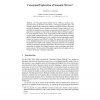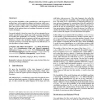148 search results - page 22 / 30 » Improving simulation-based verification by means of formal m... |
TLDI
2010
ACM
13 years 7 months ago
2010
ACM
Interactive programs, such as GUIs or spreadsheets, often maintain dependency information over dynamically-created networks of objects. That is, each imperative object tracks not ...
ICSE
2005
IEEE-ACM
14 years 7 months ago
2005
IEEE-ACM
Embedded systems are pervasive and frequently used for critical systems with time-dependent functionality. Dwyer et al. have developed qualitative specification patterns to facili...
ICFCA
2005
Springer
14 years 1 months ago
2005
Springer
Abstract. The “Semantic Mirrors Method” (Dyvik, 1998) is a means for automatic derivation of thesaurus entries from a word-aligned parallel corpus. The method is based on the c...
POPL
2004
ACM
14 years 7 months ago
2004
ACM
We prove the decidability of the quantifier-free, static fragment of ambient logic, with composition adjunct and iteration, which corresponds to a kind of regular expression langu...
FAC
2008
13 years 7 months ago
2008
Abstract. Slicing is a program analysis technique that was originally introduced to improve program debugging and understanding. The purpose of a slicing algorithm is to remove the...


